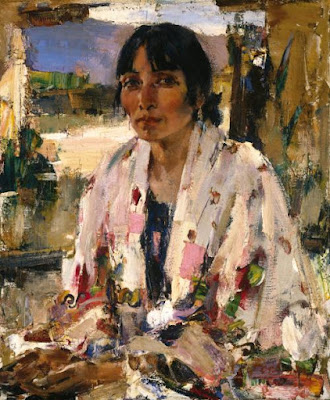I want lockdown consigned to the dustbin of history, but I’d like to see virtual museums continue to grow.
 |
| Detail of The Night Watch super image by the Rijksmuseum. (It’s a nose.) Get that close to a painting in a museum and you’ll get thrown out or worse. |
When I came home from Argentina, I expected lockdown to last a few more weeks. Now we’re talking about cancellations into next autumn. It seems like it’s going to be a long time before I’m able to spend a few hours aimlessly potting around a museum.
But museums have stepped up to the challenge of isolation. It helps that they were starting from a solid base. Most major institutions have been sharing their collections online, either in part or in full, for several years. For someone who learned art history from books and slides, this is a great resource.
 |
|
Albidia, by Nicolai Fechin, c. 1920s, courtesy of the Philbrook Museum. No, I wouldn’t have driven to Tulsa to see it, but I did enjoy studying it online. |
I chose the Philbrook Museum at random, but I think they’re pretty typical. Closer to home, I was planning (in my desultory way) to visit the Isabella Stewart Gardner Museumand the Clark Institute this summer as I crisscrossed Massachusetts to see my kids. Never mind; I’ll visit them online—the kids and the museums.
 |
|
Two Guides, 1877, Winslow Homer. The only way I’m going to enjoy the Clark Institute’s superb collection right now is online. |
Rembrandt’s The Night Watch is one of the world’s celebrated cultural treasures. It was twice damaged by mentally-disturbed vandals. Its home, the Rijksmuseumin Amsterdam, was closed for a long period of renovation. The painting itself underwent a massive restoration and is now visible under LED lighting to reduce UV radiation damage.
Still, the vast majority of artists, art historians, and art lovers will never have the opportunity to study it in person. Last month the Rijksmuseum published a 44.8 gigapixel image of it, which you can view here. It was made from 528 still photographs “stitched together digitally with the aid of neural networks,” the museum announced.
The image was made for scientific purposes, but it’s an invaluable resource for those of us who once visited museums to stand too close to the paintings just to peer at the brushwork. Best of all, it’s touch-screen sensitive.
 |
| Portrait of Dr. Samuel D. Gross (The Gross Clinic), 1875, Thomas Eakins, is the subject of an excellent digital ‘close read’ by critic Jason Farago. Courtesy Philadelphia Museum of Art. |
Art critic Jason Farago of the New York Times recently did a close read of Thomas Eakin’s Portrait of Dr. Samuel D. Gross (The Gross Clinic), 1875, which lives at the Philadelphia Museum of Art. It’s like being on a tour with a great docent—personal, informative, never didactic. You can watch it here.
I want lockdown to be consigned to the dustbin of history, but I’m enthusiastic about virtual museums. I hope they continue to expand. Great art is a cultural legacy as much as a commodity. It should be available to as many people as possible.




